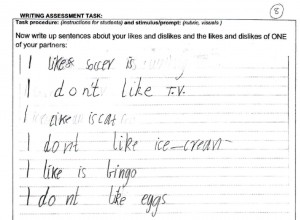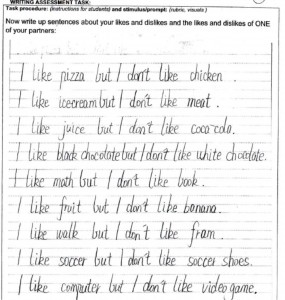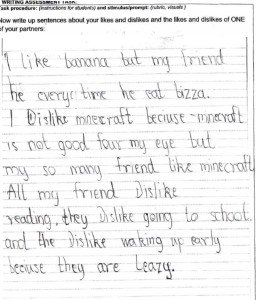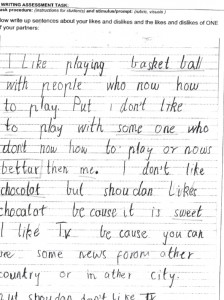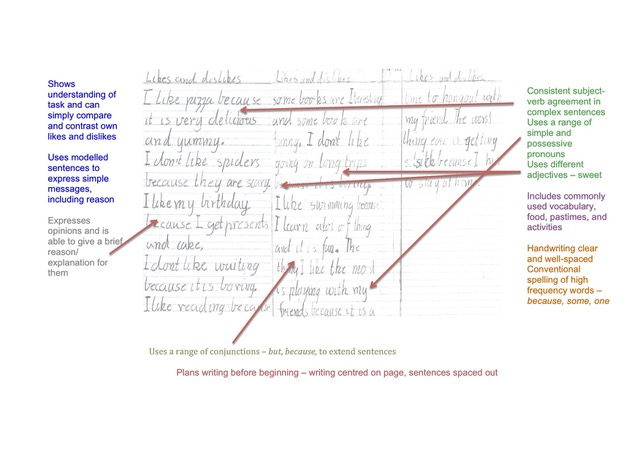Please click on the toggles below to navigate through information on this assessment task and reveal the links for downloading task materials.
Task details |
|
| Name of writing assessment task | Likes and dislikes |
| EAL curriculum level range | BL, CL, A2, B1, B2, C1, C2 |
| Text orientation | Informative |
| Task type | Extended response |
Task specification |
|
| Purpose | To assess students’ ability to express personal preferences in writing. |
| Description | Students talk about their likes and dislikes, and record them on a proforma. They also record the likes and dislikes of a friend. The students are given sentence starters, and interview questions and complete a chart recording the answers. |
| Assumed knowledge and description |
|
Learning/teaching context |
|
| Language centre/mainstream class | Small group |
| Subject/key curriculum objectives, outcomes | English |
| Topic/teaching unit | Expressing likes and dislikes |
| Assessment conditions |
|
| Notes |
|
Task implementation |
|
| STAGE | ACTION STEPS |
| Pre-assessment activity |
|
| Assessment activity |
|
| Post-assessment activity |
|
- TEAL Writing task 7 – unmarked criteria sheet [PDF]
- TEAL Writing Task 7 – unmarked criteria sheet [Word]
An explanation of the purpose, nature and use of criteria sheets is available at 4. Using the assessment criteria.
Purpose and value of the task
In this task students write a simple informative text. They are asked to complete a simple record of their own likes and dislikes, and then to ask one to two fellow students their likes and dislikes. They then write an extended response, detailing their own likes and dislikes and comparing them to another student. This task is suited to EAL learners at the earlier stages of their EAL learning, but is too demanding for students at Levels A1, BL or CL of the Victorian Curriculum F-10 EAL.
Contextual information
All of these samples were produced in the context of a primary new arrivals EAL class. The students were prepared for the task and had access to modelled sentences, word lists and dictionaries. The students were given the task sheet, which guided the writing.
Commentary
Most of these samples were produced in the context of a primary new arrivals EAL class, except Sample 4, which was produced in a mainstream Year 2 class. The students were prepared for the task and had access to modelled sentences, word lists and dictionaries. The student who produced Sample 4 was also encouraged to produce an extended text and use conjunctions such as but and because. The students were given the task sheet, which guided the writing.
Sample 1
Age/year level: Upper primary
 This sample shows that the student has made extensive use of teacher support by attempting to reproduce or copy the modelled sentence beginnings provided. The student has used the modelled vocabulary to complete simple subject-verb-object sentences. The student, adds is, inappropriately, to a few sentences. The student has also used a rubber to attempt to correct the writing. The student has not yet attempted to write sentences about a partner’s preferences.
This sample shows that the student has made extensive use of teacher support by attempting to reproduce or copy the modelled sentence beginnings provided. The student has used the modelled vocabulary to complete simple subject-verb-object sentences. The student, adds is, inappropriately, to a few sentences. The student has also used a rubber to attempt to correct the writing. The student has not yet attempted to write sentences about a partner’s preferences.
The sample shows an awareness that English is written from left to right and that spaces are needed between words. The student is able to form most letters and words legibly, but not yet always correctly. For example, l and k are written with variable formation and there is a transcription error at the end of ice-crean.
In the first attempt, don’t has been copied correctly, with an apostrophe, but it has not been used in subsequent sentences. The student has not used full stops at the end of the sentences. The sample is not sufficient to show the student’s awareness of the use of upper and lower case letters.
The marked criteria sheet shows that the student meets most criteria at level 1 of performance.
The student’s language use in this task is consistent with the descriptions of students at Level B1, Victorian Curriculum F-10 EAL.
TEAL Writing Task 7 – criteria sheet – Sample 1
Using this assessment for further learning
Students working at this level benefit from taking part in a range of modelled writing, and joint construction of text, leading into attempting their own writing. Oral activities, such as picture discussions, prior to writing, are important to build up topic vocabulary and structures. Photos of the student engaging in role plays, with speech balloons and thought bubbles, could model the structures in an engaging way.
The student may benefit from vocabulary extension activities and resources to be able to add more information to a subsequent draft of the text. This may need to be with bilingual support, and visuals, to assist the student’s comprehension as the student appears to be in the beginning stages of English language learning, and writing, in English. The student could then add these words to a personal dictionary or word bank.
The student would also benefit from instruction, and practice, on the use of full stops at the end of sentences.
Give the student time and support to write and illustrate another draft. As this student is at a very early point in his or her English language learning, ask the student to reread the writing, and scribe grammatically correct sentences for the student to copy or type onto a computer, so that a correct subsequent draft can be produced. It is important for students to redraft or copy to produce a corrected text, especially if the text is to be displayed. Add this to the student’s writing portfolio along with the original draft.
Sample 2
Age/year level: upper primary
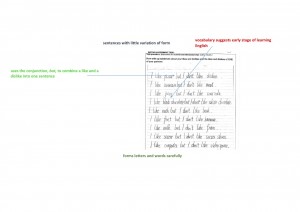
This sample shows that the student has made extensive use of teacher support by copying the modelled sentence structures provided. The student has reproduced sentences with little variation of form, suggesting that they may not yet have enough English to use their own words and constructions to express their ideas. The student does use the conjunction but to combine a like and a dislike into one sentence.
Although the student uses the plural s in shoes, it is not used appropriately in other words such as banana, computer and book. This suggests the student would benefit from instruction in this area. The student’s use of vocabulary such as black, chocolate and math, suggest that the student is at an early stage of learning English.
The neatness and care with which the writing has been done shows an awareness of quite advanced concepts of print, such as appropriate spacing between words and sentences, and layout of the text on the page. The student is able to form letters and words carefully, neatly and legibly, and uses full stops appropriately at the end every sentence.
The student has not yet attempted to write sentences about a partner’s preferences.
The marked criteria sheet shows that the student meets some criteria at level 1 of performance and some at level 2.
The student’s language use in this task is consistent with the descriptions of students at Level B1, Victorian Curriculum F-10 EAL.
TEAL Writing Task 7 – criteria sheet – Sample 2
Using this assessment for further learning
Students working at this level benefit from taking part in a range of modelled writing activities such as joint construction of text, for a range of purposes, leading into their own writing. Oral activities, such as picture discussions, prior to writing, are important to build up topic vocabulary and structures. Photos of the student engaging in role plays, with speech balloons and thought bubbles, could model the structures in an engaging way.
The student may benefit from vocabulary extension to be able to add more information. This may need to be with bilingual support, or visuals, to assist the student’s comprehension in English. The student could then add these words to a personal dictionary or word bank.
The student would benefit from instruction, and practice, of singular vs plural forms for general, countable nouns. The student could engage in activities such as classifying and grouping nouns under the headings of One (singular) vs More than one (plural) and completing charts with pictures and some matching words missing.
The student would also benefit from practising spelling, farm, and then build up a list of words containing the diphthong, ar, such as car, start etc.
Using pictures or realia, explain to the student that we say dark chocolate and milk chocolate rather than black chocolate. Also explain that in Australia, we say maths, which is a short form of mathematics.
The student could benefit from encouragement to move away from the ‘safety’ of only using the modelled sentence structure. Ask the student to reread the text, then discuss what the student likes and dislikes and why. This should encourage the student to use more spontaneous and interesting constructions. Scribe some of this for the student to be added to another draft. Add both pieces of writing to the student’s writing portfolio.
Sample 3
Age/year level: upper primary
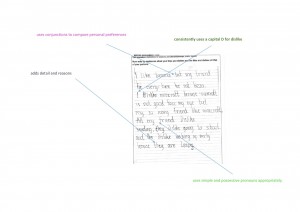
This sample shows that the student has used the modelled sentence structures provided as a framework but has written sentences with extended forms, suggesting that they have enough confidence in their own words and constructions to express their ideas and add detail. Although the student’s structures are developing, the writing effectively conveys its meaning in an engaging way. The student includes information about friends’ preferences.
The student uses the conjunctions, but and and, to compare personal preferences with those of friends, as well as because to give reasons for them. The student effectively uses the negative form, not as well as the gerund in words such as, waking and going. The student also uses simple and possessive pronouns appropriately.
The student does not use the generalised plural s appropriately in words such as, banana, eye and friend. Nor does the student use the final s in he eat(s). This suggests the need for a pronunciation, as well as a grammar focus, to highlight the word endings. The spelling of bizza also suggests the need for differentiation between p and b sounds.
The sample shows that the student is able to write clearly and legibly, and uses full stops appropriately at the end of every sentence. The student commences each new sentence with a capital letter but consistently uses a capital D for dislike within sentences.
The marked criteria sheet shows that the student meets most criteria at level 3 of performance.
The student’s language use in this task is consistent with the descriptions of students at Level B2, Victorian Curriculum F-10 EAL.
TEAL Writing Task 7 – criteria sheet – Sample 3
Using this assessment for further learning
Students working at this level continue to benefit from taking part in a range of modelled writing and joint construction of text for a range of purposes, leading into their own writing. Oral activities, such as picture discussions, prior to writing, are important to build up topic vocabulary and structures. Photos of the student engaging in role plays, with speech balloons and thought bubbles, could model the structures in an engaging way.
Ask the student to proof-read for consistency to help in picking up spelling errors such as the word, they. The student would benefit from a spelling focus on because and lazy as well as learning when to use for instead of four. The student could also be asked why a capital D has been used for dislike and to self-correct these in the text.
The student may also benefit from further vocabulary extension and brainstorming. The student could then add these words to a personal dictionary or word bank.
The student would benefit from instruction, and practice, in pronouncing the final s in plural forms for general, countable nouns and for regular third person singular verbs, such as, he/she eats, runs etc. The student could be given minimal pair picture cue cards, such as pat and bat, big and pig, to assist with the differentiation of p and b sounds.
Activities around the identified spelling errors could help the student build up lists of words that rhyme with misspelt words such as lazy. The student could begin building a collection of known and new words starting with p and b and will help the student to differentiate these sounds.
The student could fill in verb charts and focus on third person singular verb forms in cloze activities.
Give the student time and support to write and illustrate another draft. Add this to the student’s writing portfolio.
Sample 4
This text is quite long and has relatively few errors, which may reflect use of modelling provided by the teacher. However, the complexity of ideas is not equivalent to what is attempted in Sample 5 or even in Sample 3. This sample demonstrates greater control over the language used than Samples 3 and 5. Perhaps this reflects the differing level of maturity between this student in Grade 2 who is at the final level of Pathway A in the Victorian Curriculum F-10 EAL, and the authors of Sample 3 and 5 in upper primary who attempt to express more complex meanings. At any rate, the language use in Sample 4 demonstrates both considerable accuracy and some colloquial use of language that may be used by mainstream students of the same age as this student.
The student understands the tasks, expresses opinions and includes relevant information and support, but the writing also reflects the modelling provided by the teacher. Conjunctions, especially because, are used to link ideas in sentences. These are consistently well-formed using a range of verbs and nouns appropriately. There are a very small number of grammatical errors, notably a failure to use plural for some book even though it is used correctly earlier in the same sentence. The use of colloquialisms like yummy, hangout and the worst thing ever, indicate the student is starting to use expressions used by mainstream students of the same age. The writing is clear, and the spelling is quite good with only occasional errors. The student has used a range of success-oriented strategies to produce the text.
The marked criteria sheet indicates that most aspects of the text are at levels 3 and 4 of performance for the task.
The student’s language use in this task is consistent with the descriptions of students at Level A2, Victorian Curriculum F-10 EAL. While the language use is not as sophisticated as the ideas in Samples 3 and 5, aspects of this text suggest that this student may be approaching mainstream expectations appropriate for students in grade 2.
Teal Writing Task 7 – criteria sheet – Sample 4
Using the assessment for further learning
- Use different structures to add variety to the text I like (pizza/my birthday etc.) because (it is very delicious/I get presents and cake etc.).
• Ask the student to look at the following table, and to write some sentences about their own likes and dislikes in the right hand column, following the pattern given in the left-hand column. Here are some other ways of writing these sentences: I don’t like (spiders/waiting etc.) because (they are scary/it is boring etc.).
• Point out to the student they used the following sentence structure a lot, and so the text did not seem as interesting as it could have.
| More sentence structures for writing about likes and dislikes | My examples |
| Pizza is very delicious and so I like it. | |
| Spiders are scary and so I don’t like them. | |
| Because I get presents and cake, I like my birthday. | |
| Because waiting is boring, I don’t like it. |
2. Explain to the student how repetition of a sentence structure can seem repetitive, and boring, so many readers dislike such writing! Explain that readers will like your writing more when it uses a variety of sentence structures.
Rewrite the text so no two sentences have the same structure.
Sample 5
Age/year level: upper primary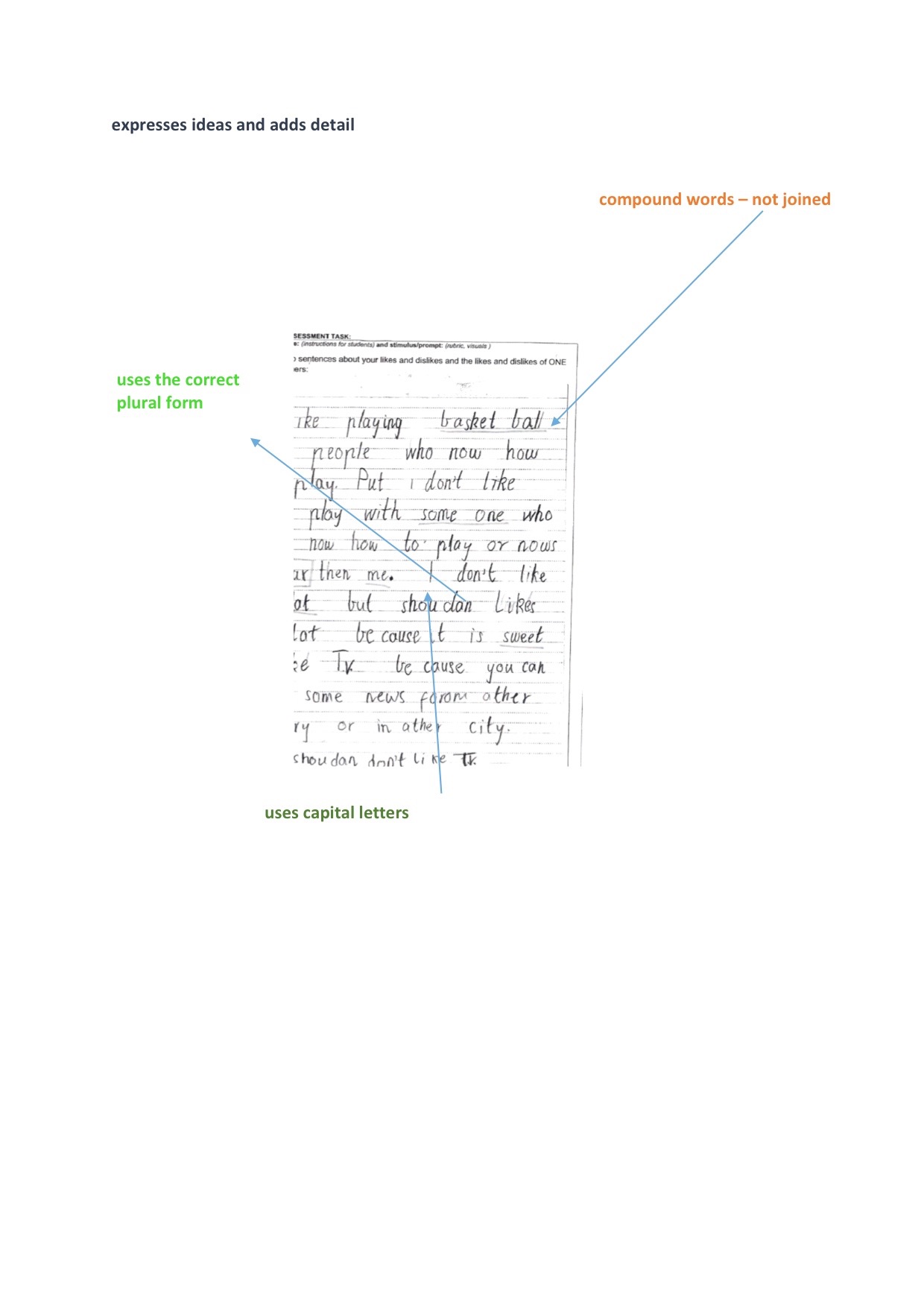
This sample shows that the student has used the modelled sentence structures provided as an organising framework but has reproduced sentences with extended forms, suggesting that they have enough confidence and ability to express their own ideas and add detail. Although the student’s structures are developing, the writing effectively conveys its meaning.
The student uses several conjunctions, including, but and or, to compare, and because to give reasons. The student effectively uses both the gerund, playing and infinitive form of to play. The student uses simple pronouns, and the relative pronoun, who, appropriately. The student also uses several prepositions such as to, with, in and forom (sic) correctly, in context.
The student does not use the plural of words such as, country and city but uses the correct plural form of people. The student uses don’t like in the final sentence to make a negative, instead of doesn’t when writing about others.
The sample shows that the student is able to write clearly and legibly and sets the writing out neatly on the page. The student commences each new sentence with a capital letter and uses full stops at the end of most sentences. However, the student doesn’t use a capital letter, for the partner’s name.
The marked criteria sheet shows that the student meets most criteria at level 4 of performance.
The student’s language use in this task is consistent with the descriptions of students at Level B2, Victorian Curriculum F-10 EAL.
TEAL Writing Task 7 – criteria sheet – Sample 5
Using this assessment for further learning
Students working at this level continue to benefit from taking part in a range of modelled writing activities, and joint construction of text, for a range of purposes, leading into their own writing. Oral activities, such as picture discussions, prior to writing, are important to build up topic vocabulary and structures. Photos of the student engaging in role plays, with speech balloons and thought bubbles, could model the structures in an engaging way.
Ask the student to reread the text and to do some self-assessment, such as underlining or highlighting the words that may be wrongly spelt, or where it might be grammatically incorrect. Discuss with the student, and provide corrections if the student is not able to. Note any self-correcting the student may do to the grammar as they reread, and note this down for the student to incorporate into a redraft of the text.
The student would benefit from a spelling focus on the common errors, bettar, chocolat, forom, than (for then) and nows. The student could also be shown the idea of compound words such as someone and basketball.
Ask the student to say shouldon slowly, and ask if he or she means should not or shouldn’t. If so, point out that the word dislike works better in this sentence than don’t like.
The student would benefit from further vocabulary extension and brainstorming. The student could then add these words to a personal dictionary or word bank.
The student would benefit from instruction, and practice, of pronouncing the final s in plural forms for general, countable nouns and for regular third person singular verbs, such as, he/she eats runs etc.
The student could engage in activities such as classifying and grouping nouns under the headings of One (singular) and More than one (plural), and completing charts with pictures and some matching words missing.
The student could fill in verb charts and focus on third person singular verb forms in cloze activities.

